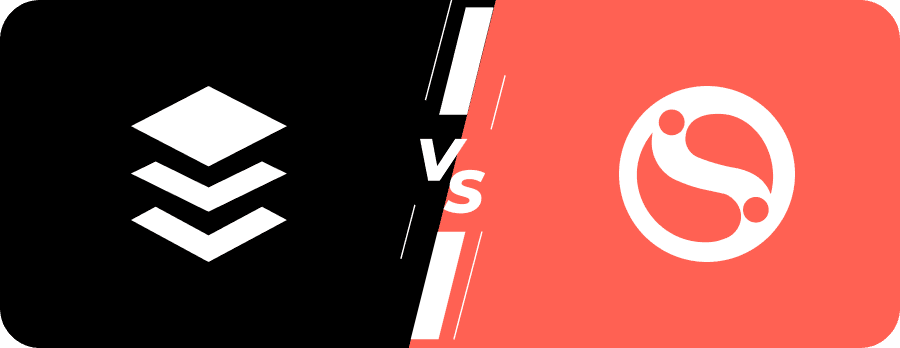
Buffer vs Sendible
Which Is Best in 2025?
What is Buffer?
Founded in 2010, Buffer quickly became one of the most popular and accessible social media management tools. The platform’s mission is simple: to provide businesses of all sizes with an easy-to-use tool that helps them schedule, publish, and analyze social media content from one place.
Who it’s best suited for:
Buffer is ideal for small to medium-sized businesses, solo entrepreneurs, and teams that need a streamlined, budget-friendly solution. Its user-friendly design and solid features make it a great choice for businesses that don’t need complex analytics or enterprise-level integrations but still want the ability to schedule and analyze their social media content effectively.
What is Sendible?
Sendible was founded in 2009 and is known for its robust features and scalability. With a focus on providing an all-in-one solution for agencies, businesses, and large teams, Sendible aims to make social media management easier and more effective.
Who it’s best suited for:
Sendible is particularly well-suited for larger teams, agencies, and businesses with more complex needs. With its wide array of integrations, advanced reporting features, and client management tools, Sendible provides a comprehensive solution for social media managers who need scalability and advanced features to support multiple clients and campaigns.
Other Sendible Comparisons
Overview
In today’s online world, businesses and individuals alike face an increasing need to manage multiple social media accounts effectively. The right social media management tool can make all the difference in streamlining workflows, improving engagement, and optimizing marketing efforts. Whether you’re a small business owner, a social media manager, or part of an agency, choosing the best tool for your needs can be overwhelming.
In this comparison, we’ll explore the strengths and weaknesses of Buffer vs. Sendible, based on firsthand experience in social media management and feedback from platforms like G2 and Capterra. By the end, you’ll have a clearer understanding of which tool suits your needs best, whether you’re managing a single brand or multiple clients.
Buffer vs Sendible: User Rating
| Rating Categories | Buffer | Sendible |
| Star Rating (Out of 5) | 4.6 | 4.7 |
| Meets Requirements (Out of 10) | 8.9 | 9.0 |
| Ease of Use (Out of 10) | 9.1 | 9.0 |
| Ease of Setup (Out of 10) | 9.3 | 9.1 |
| Ease of Admin (Out of 10) | 9.0 | 8.9 |
| Quality of Support (Out of 10) | 8.8 | 9.0 |
| Business Partnership (Out of 10) | 8.7 | 8.8 |
| Product Direction (% positive) | 88 | 89 |
G2 Rating: 4.3/5 (1,000+ reviews)
Capterra Rating: 4.5/5 (1,400+ reviews)
Buffer is highly appreciated for its ease of use, simplicity, and affordable pricing, but some users feel that its analytics capabilities are limited for businesses needing more detailed insights.Sendible
G2 Rating: 4.5/5 (800+ reviews)
Capterra Rating: 4.6/5 (100+ reviews)
Sendible is favored by agencies and larger teams for its social listening, reporting, and analytics features. However, it may feel overwhelming for new users, and the higher pricing could be a drawback for smaller businesses or individuals.
Buffer vs Sendible: Feature Comparison
| Features | Buffer | Sendible |
| Pricing (per month in USD) | 15$ | 29$ |
| Free Trial | Yes | Yes |
| Platforms Supported | Most Major Platforms | All Platforms |
| Bulk Scheduling | Yes | Yes |
| RSS feeds | No | Yes |
| Content Suggestions | No | Yes |
| Social Inbox | No | Yes |
| Advanced Analytics | Yes | Yes |
| Approval Workflow | No | Yes |
| URL Shortener | Yes | Yes |
| Team Management | Yes | Yes |
a. Scheduling and Automation
Buffer:
As someone who’s tested Buffer extensively for scheduling content across multiple social media accounts, I’ve found its simplicity to be a big plus. The platform’s intuitive scheduling is perfect for smaller teams or solo social media managers who don’t want to spend too much time getting familiar with the platform. The drag-and-drop functionality in the content calendar is smooth, and the “Auto Schedule” feature takes the guesswork out of timing. However, when I needed to schedule recurring posts or leverage automation for evergreen content, Buffer didn’t quite offer that depth. I had to manually reschedule the same posts, which became tedious when managing multiple campaigns.
Sendible:
On the other hand, Sendible really stood out in terms of automation and scheduling when I worked on larger campaigns for clients. The recurring post feature was a game-changer—especially when managing content that needs to be posted regularly (like blog promotions or seasonal offers). Sendible’s “Smart Queue” was incredibly helpful too, as it auto-scheduled posts at peak engagement times based on data from previous posts. It saved me from manually adjusting the timing for every post. For businesses that rely heavily on automation, Sendible’s features are definitely more robust, allowing for a more streamlined, less hands-on approach.
b. Supported Social Media Platforms
Buffer:
Buffer’s platform support is solid—Facebook, Instagram, Twitter, LinkedIn, and Pinterest are all covered, which works great for many businesses. However, I remember a time when I was working with a client who had a significant YouTube presence and wanted to manage everything in one place. That’s when I realized Buffer didn’t support YouTube. If you’re managing a highly visual, video-centric social media strategy, this could be limiting. While Buffer works well for traditional social media channels, for video-heavy content, you might need to look elsewhere.
Sendible:
Sendible, however, quickly became my go-to platform for clients who needed to manage a wide array of platforms, including YouTube and even Google My Business. I appreciated that I could manage everything from one dashboard, and I didn’t have to use third-party tools for video or local business content. For one of my retail clients, Sendible’s ability to manage both Instagram for visual content and Google My Business for location-based promotions made life much easier. The fact that it supports platforms like TikTok and Tumblr is a bonus for businesses exploring newer or niche platforms.
c. Analytics and Reporting
Buffer:
When I first started using Buffer, I loved how easy it was to track basic metrics like engagement and follower growth. For small businesses or personal brands, Buffer’s analytics are more than sufficient. However, I remember the frustration of not being able to dive deeper into performance data. For a campaign I was running for a client, I wanted more granular insights (like audience demographics or behavior analysis), and I quickly realized that Buffer wasn’t equipped for that level of analysis. If you’re just looking to get a general sense of how your posts are performing, it works fine. But if you’re working on data-driven campaigns, you might feel limited.
Sendible:
Sendible, on the other hand, really impressed me with its in-depth analytics and reporting. I loved the ability to generate custom reports for my clients that not only included detailed engagement data but also compared performance across different platforms. When I worked with larger clients who needed audience insights and competitor benchmarks, Sendible made this so much easier. One of the key features I appreciated was the ability to create white-label reports, making it more professional when presenting data to clients. For businesses with serious reporting needs, Sendible’s analytics are the clear winner.
d. User Interface and Experience
Buffer:
For someone who values simplicity, Buffer’s interface was an immediate win. It’s clean, user-friendly, and intuitive—perfect for anyone just getting started with social media management. I remember the first time I set up Buffer for a small local business, and it took me less than an hour to get everything organized. The learning curve is almost non-existent, and for smaller teams, this is a huge benefit. However, for those managing a wide range of campaigns or needing more collaborative features, I did find the lack of complex tools a bit restrictive after a while.
Sendible:
When I tested Sendible, I noticed the interface was packed with features, which made it slightly overwhelming at first. However, once I got familiar with it, the experience became much smoother—especially for team collaboration. The platform allows you to assign roles and set up approval workflows, which is invaluable when you’re managing a large team or multiple clients. I was managing social accounts for a mid-sized agency, and the ability to delegate tasks while maintaining oversight through approval workflows made Sendible a powerhouse. It took a little getting used to, but once I understood how to leverage its features, it saved me a lot of time in the long run.
e. Pricing Comparison
Buffer offers a more budget-friendly structure, especially for smaller teams or individual users. The free plan and lower-cost starter plans make it more accessible for startups or those just beginning their social media journey.
Sendible, while more expensive, offers a better range of features for agencies or businesses that manage numerous clients. The Starter Plan is pricier than Buffer’s but includes more social profiles and additional functionalities. For those who require a high level of customization and advanced analytics, Sendible’s higher-tier plans provide significant value.
Pros and Cons of Using Buffer
Pros
- Affordable for small businesses and solo users.
- User-friendly interface.
- Advanced post scheduling.
- Solid reporting tools.
Cons
- Limited integrations.
- No content curation or social listening features.
- Limited collaboration features on lower plans.
Pros and Cons of Using Sendible
Pros
- Comprehensive social media management features.
- Extensive integrations.
- Advanced analytics.
- Strong collaboration tools.
Cons
- Higher cost.
- Steep learning curve.
- No free plan.
Ideal Use Cases
Buffer is best for small businesses, solopreneurs, and freelancers who need an easy-to-use, cost-effective solution for scheduling and publishing posts across a few social media platforms.
Sendible excels in situations where there’s a need for advanced features like social listening, content curation, detailed analytics, and team collaboration, making it ideal for agencies or larger businesses managing multiple clients and campaigns.
Conclusion of Buffer vs. Sendible Comparison
Choosing between Buffer and Sendible largely depends on your business size, budget, and specific social media management needs.
When deciding between Buffer and Sendible, consider the scale of your business or team. If you need a straightforward and cost-effective tool, Buffer is your go-to. However, if you require more advanced capabilities—especially for social listening and reporting—Sendible might be worth the investment.
For businesses seeking a balance of features, ease of use, and pricing flexibility, RecurPost is an excellent alternative that addresses many of the pain points both Buffer and Sendible leave behind.





